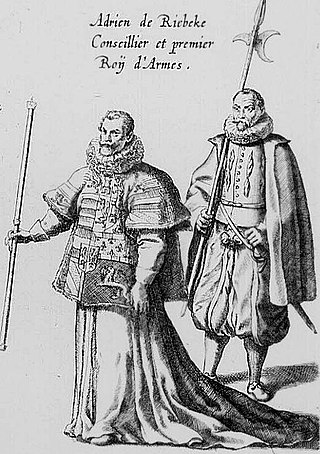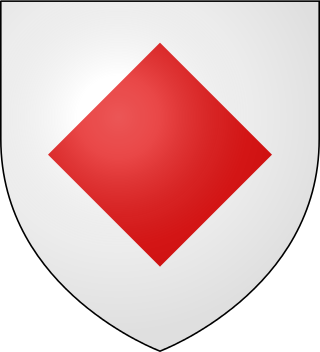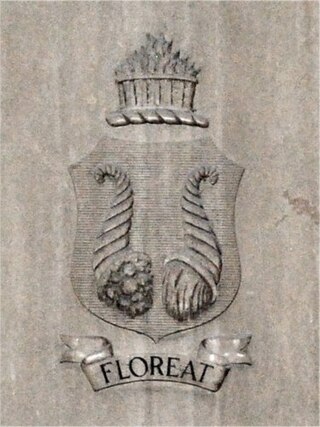
Heraldry is a discipline relating to the design, display and study of armorial bearings, as well as related disciplines, such as vexillology, together with the study of ceremony, rank and pedigree. Armory, the best-known branch of heraldry, concerns the design and transmission of the heraldic achievement. The achievement, or armorial bearings usually includes a coat of arms on a shield, helmet and crest, together with any accompanying devices, such as supporters, badges, heraldic banners and mottoes.
A coat of arms is a heraldic visual design on an escutcheon, surcoat, or tabard. The coat of arms on an escutcheon forms the central element of the full heraldic achievement, which in its whole consists of a shield, supporters, a crest, and a motto. A coat of arms is traditionally unique to the armiger. The term "coat of arms" itself, describing in modern times just the heraldic design, originates from the description of the entire medieval chainmail "surcoat" garment used in combat or preparation for the latter.

The Genealogical Office is an office of the Government of Ireland containing genealogical records. It includes the Office of the Chief Herald of Ireland, the authority in Ireland for heraldry. The Chief Herald authorises the granting of arms to Irish bodies and Irish people, including descendants of emigrants. The office was constituted on 1 April 1943 as successor to the Ulster King of Arms, established during the Tudor period of the Kingdom of Ireland in 1552. The Ulster King of Arms' duties in relation to Northern Ireland were taken over by the Norroy and Ulster King of Arms.
In heraldry, a compartment is a design placed under the shield, usually rocks, a grassy mount, or some sort of other landscape upon which the supporters are depicted as standing. Care must be taken to distinguish true compartments from items upon which supporters are merely resting one or more feet, or, sometimes, mere heraldic badges or pure decoration under the shield, and, conversely, care must also be taken in very unusual cases such as the coat of arms of Belize and Gabon, in which what may be taken to be a crest, trees in both coats of arms rising above the shield, is really part of the compartment. It is sometimes said to represent the land held by the bearer. As an official part of the blazon it is a comparatively late feature of heraldry, often derived from the need to have different supporters for different families or entities, although sometimes the compartment is treated in the blazon separately from the supporters.

The lines in heraldry used to divide and vary fields and charges are by default straight, but may have many different shapes. Care must be taken to distinguish these types of lines from the use of lines as charges, and to distinguish these shapes from actual charges, such as "a mount [or triple mount] in base," or, particularly in German heraldry, different kinds of embattled from castle walls.

King of arms is the senior rank of an officer of arms. In many heraldic traditions, only a king of arms has the authority to grant armorial bearings and sometimes certify genealogies and noble titles. In other traditions, the power has been delegated to other officers of similar rank.

The coat of arms of Ireland is blazoned as Azure a harp Or, stringed Argent. These arms have long been Ireland's heraldic emblem. References to them as being the arms of the king of Ireland can be found as early as the 13th century. These arms were adopted by Henry VIII of England when he ended the period of Lordship of Ireland and declared Ireland to be a kingdom again in 1541. When the crowns of England, Scotland and Ireland were united in 1603, they were integrated into the unified royal coat of arms of kingdoms of England, Scotland and Ireland. The harp was adopted as the emblem of the Irish Free State when it separated from the United Kingdom in 1922. They were registered as the arms of Ireland with the Chief Herald of Ireland on 9 November 1945.

The lozenge in heraldry is a diamond-shaped rhombus charge, usually somewhat narrower than it is tall. It is to be distinguished in modern heraldry from the fusil, which is like the lozenge but narrower, though the distinction has not always been as fine and is not always observed even today. A mascle is a voided lozenge—that is, a lozenge with a lozenge-shaped hole in the middle—and the rarer rustre is a lozenge containing a circular hole in the centre. A lozenge throughout has "four corners touching the border of the escutcheon". A field covered in a pattern of lozenges is described as lozengy; similar fields of mascles are masculy, and fusils, fusily. In civic heraldry, a lozenge sable is often used in coal-mining communities to represent a lump of coal.
The Heraldry Council is part of the South African heraldic authority, established in Pretoria in June 1963, in terms of the Heraldry Act. It is the governing and policy-making body for the Bureau of Heraldry and consists of the National Herald ex officio, and other members appointed by the Minister of Arts and Culture.

The Canadian Heraldic Authority is part of the Canadian honours system under the Canadian monarch, whose authority is exercised by the Governor General of Canada. The authority is responsible for the creation and granting of new coats of arms, flags, and badges for Canadian citizens, government agencies, municipal, civic and other corporate bodies. The authority also registers existing armorial bearings granted by other recognized heraldic authorities, approves military badges, flags, and other insignia of the Canadian Forces, and provides information on heraldic practices. It is well known for its innovative designs, many incorporating First Nations symbolism.
The Public Register of Arms, Flags and Badges of Canada contains the heraldic emblems that have been granted, registered, approved or confirmed by the Canadian Heraldic Authority since its inception on June 4, 1988. In 2005, the Canadian Heraldic Authority began the process of creating a digital version of the register available online.
The law of heraldic arms, sometimes simply laws of heraldry governs the possession, use or display of arms, called bearing of arms. That use includes the coats of arms, coat armour or armorial bearings. Originally with the sole function of enabling knights to identify each other on the battlefield, they soon acquired wider, more decorative uses. Today they are used by countries, public and private institutions or individuals. The first laws regarding arms were written by Bartolus de Saxoferrato and the officials who administer these matters today are called pursuivants, heralds, or kings of arms. The law of arms is part of the law in countries which regulate heraldry, although not part of common law in England and in countries whose laws derive from English law. In most European countries without monarchies, much like in the United States, there are no laws against assuming arms, with the closest legal authenticity mechanism being a pictorial copyright protection.

The coat of arms of Namibia is the official heraldic symbol of Namibia. Introduced at the time of independence in 1990, it superseded the earlier coat of arms used by the South African administration of the territory.

Fraser Herald of Arms is the title of one of the officers of arms at the Canadian Heraldic Authority in Ottawa. Like the other heralds at the Authority, the name is derived from the Canadian river of the same name. Since the inception of the office, Fraser Herald of Arms has been the principal artist of the Canadian Heraldic Authority. As such, Fraser is responsible for overseeing the artwork created for all grants of arms emanating from the Authority.

South African heraldry dates back to the 1650s, inheriting European heraldic traditions. Arms are borne by individuals, official bodies, local authorities, military units, and by a wide variety of organisations. South Africa has had its own heraldic authority since 1963, to provide armigers with legal protection, and to promote high standards of armorial practice.
Irish heraldry is the forms of heraldry, such as coats of arms, in Ireland. Since 1 April 1943 it is regulated in the Republic of Ireland by the Office of the Chief Herald of Ireland and in Northern Ireland by Norroy and Ulster King of Arms. Prior to that, heraldry on the whole island of Ireland was a function of the Ulster King of Arms, a crown office dating from 1552. Despite its name the Ulster King of Arms was based in Dublin.

Frederick Gordon Brownell was a South African herald, vexillologist, and genealogist.

Canadian heraldry is the cultural tradition and style of coats of arms and other heraldic achievements in both modern and historic Canada. It includes national, provincial, and civic arms, noble and personal arms, ecclesiastical heraldry, heraldic displays as corporate logos, and Canadian blazonry.
A heraldic authority is defined as an office or institution which has been established by a reigning monarch or a government to deal with heraldry in the country concerned. It does not include private societies or enterprises which design and/or register coats of arms. Over the centuries, many countries have established heraldic authorities, and several still flourish today.

Australian heraldry is the style and tradition of using armorial achievements, sometimes known as coats of arms, and other heraldic bearings and insignia in Australia. It largely follows the Gallo-British tradition of heraldry also followed in England, Scotland, Ireland, Canada and New Zealand.













